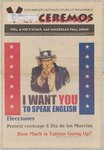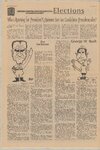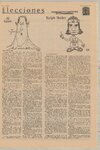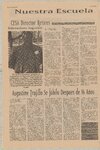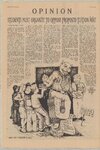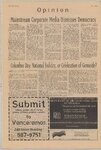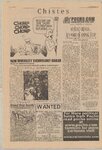| OCR Text |
Show nec The National Conference for Community and Justice BIRMINGHAM PLEDGE IT. LIVE 1T l SIGN a A | believe that every person | believe that every person race has worth as an individual. is entitled to dignity and respect, regardless of or color. Il believe that every thought and every act of racial prejudice is harmful; if it is my thought or act, then it is harmful to me as well as to others. JOIN THE CHICANA/O MOVEMENT! WORK WITH VENCEREMOS! CALL 587-9751 Therefore, from this day forward | will strive daily to eliminate racial prejudice from my thoughts and actions. | will discourage raciai prejudice by others at every opportunity. | will treat all people with dignity and respect; and | will strive daily to honor this pledge, knowing that the world will be a better place because of my effo rt. SIGNATURE PLEASE PRINT NAME STREET ADDRESS CITY/STATE ZIP CODE - ORGANIZATION DATE web: http://www.onb.org Marcha from page 13 He reported on issues the Chicano community, and refused to back down when threatened by the police if he did not tone down his stories. . During the march Salazar was having a drink at the Silver Dollar Bar with some colleagues when police surrounded the bar, forcing several exiting patrons back inside. The officers said they were looking for an individual with a gun who had actually been arrested a short time earlier. They shot two tear gas projectiles into the crowded bar, and although patrons leaving the bar afterward reported several injured people inside, the officers sealed off the area and did nothing to help them. When police entered the bar several hours later they found Salazar dead, hit in the head by one of the tear gas projectiles fired earlier. The original Chicano Moratorium was a historical landmark for Chicanos and has since been commemo- rated twice. Not surprisingly, the issues addressed at the original moratorium are the same issues the Chicano community faces today. In a letter addressed to all Raza organizations and allies, the National Chicano Moratorium Committee stated that “far from being a historical commemoration, the National Chicano Moratorium Committee is calling this marcha as part of a national fight back campaign against the conditions Raza face throughout Aztlan/Occupied Mexico and the militarization of our community at the hands of police, Border Patrol, and other repressive forces of the US government.” The letter also addressed the militarization of the border, racist legislation and physical attacks against Raza in states such as Arizona, the push-out of Raza youth from schools to prisons, and US intervention in de la pagina 15 nuestro favor; tenemos un estu- diante que es regente, y se cambia anualmente por elección. Otros regentes tienen esta posición por años que les permite darse cuenta de todo. Por supuesto que es conveniente Mexico among other issues. The Committee ended the letter saying “for these reasons, the National Chicano Moratorium Committee is making this national call to all Raza who want to change our conditions and who are tired of this situation to come to Belvedere Park in East LA...” And so I found myself at Belvedere Park, the start of the first moratorium march. We were not sure where everyone was meeting but once we caught sight of a few Mexican flags waving in the breeze, we found our way. Hundreds of Chicanas/os were gathered together preparing to march. : Present at the marcha were members of such varied organizations as Refuse and Resist,-Union del Barrio, La Raza Unida Party, Movimiento Estudiantil Chi- canas/os de Aztlan, Brown Berets de Aztlan, African People's Socialist Party, and many others. After a short speech by organizers, we began our march to Salazar Park led by the members A Danza Cuahutemoc. : We marched several miles down closed off streets and were greeted by horns honking as we chanted.. “We didn't cross the border, the border crossed us!” “Esta es mi lucha, Esta es mi tierra!” and “El Pueblo unido, jamás será vencido!” were common calls among the crowd. Although there were fewer marchers than in years ast, the procession was large and hard to miss. The eeling of being artonndedB people who looked like me and who shared the same feelings and beliefs as me was amazing. When we reached the park we found a stage and many vendors and informational booths set up. The rogram began quickly as one speaker after another introduced themselves and their organization and made statements about the issues of the moratorium. Keynote speakers included Jaime Cruz, Coordinator of the National Chicano Moratorium Committee, que nuestro representante del estudiantado se le cambie anualmente así apenas se da cuenta de todo cuando se le termina su período. Los estudiantes somos siempre los desvalidos lo que significa que ya no tenemos nada para perder. Les .exorto .a que nos defendamos y que todos sepan que los estudiantes no serán el Es para salvar a la Universiad. Nosotros somos los que se supone que van a recibir el servicio aquí. Los estudiantes en Utah son ya estereotipados como apáticos ¿Por qué no Rudy Acuña, author of Occupied America and professor of Chicana/o Studies at. Cal State Northridge, Ernesto Bustillos, Chairman of Union del Barrio, and Xénarro Ayala, National Chairman of La Raza Unida Party. olidabey stacericnts were also made by Adigun Hotet of the African People's Socialist Party, Raul Salinas of the Leonard Peltier Update, Quetza Oseloaciua of the Barrio Defense Committee, San Jose, and Guillermo Suarez of the Chicano Moratorium Committee, Los Angeles, among others. After the speakers we saw cultural presentations by the band Aztlan Underground, Groundkeepers, and others. Members of the younger generation formed a mosh pit of sorts while the bands played. Along with providing a forum for the community to address the issues we are facing, the rally allowed people from various organizations to trade information and network. Publications such as The Revolutionary Worker, Zopilote Magazine, Voz Fronteriza, and Venceremos were pil out among the crowd. After the rally we attended a play by Teatro Urabano called The Silver Dollar, written and directed by Rene Rodriguez. The play was performed at the Silver Dollar Café Theater which is the actual bar where Ruben Salazar was killed 30 years ago. As the night came to a close 1 reflected on the day and what it had all meant to me. I thought about all the people we had met and how easily they welcomed us as comrades in the same struggle. I found that I identified with them and wondered what 1 needed to “do to contribute to the struggle. A statement made by Ernesto Bustillos at the rally came to mind; “Revolution is the answer.” Whether that revolution is one of the people against a government that is not serving them, or one of an individual in their mind, fighting an identity and history that has been imposed on them, it 1s the answer. tirarles eso de regreso a la cara de la administración? Nosotros sólo podemos ganar el respeto de las generaciones futuras de estudiantes. La cantidad del aumento a la cuota de inscripción aún no se sabe pero éste aumento creará un daño severo a los estudiantes en todo el estado. No creo que tengamos otra opción pero aquella de organizarnos y oponernos a cualquier aumento a la cuota de inscripción para salvar la diversidad y para mandar un mensaje claro que los estudiantes no permitirán que un montón de gente bien vestida decida lo que es mejor para NOSOtros. | “7 |
